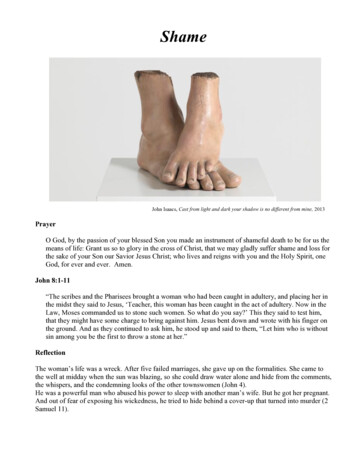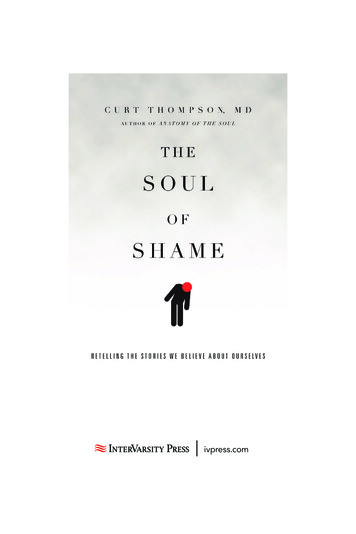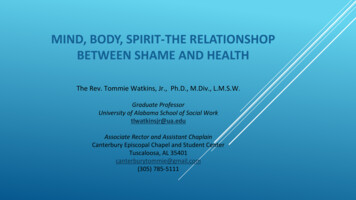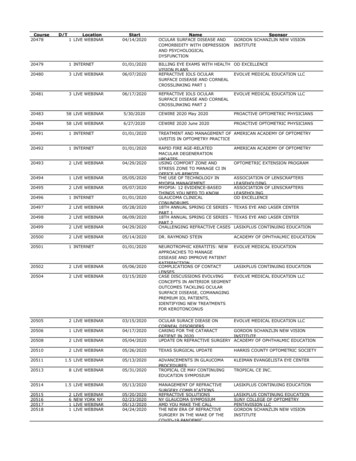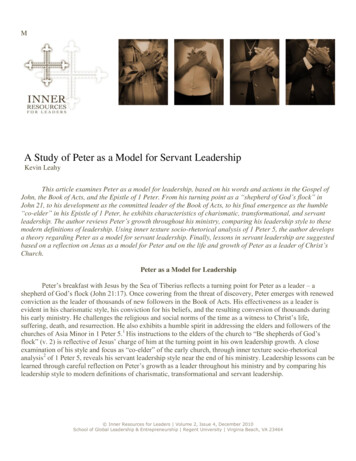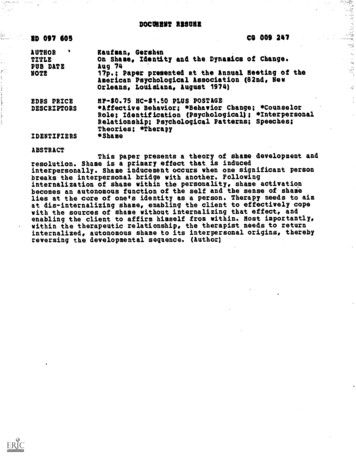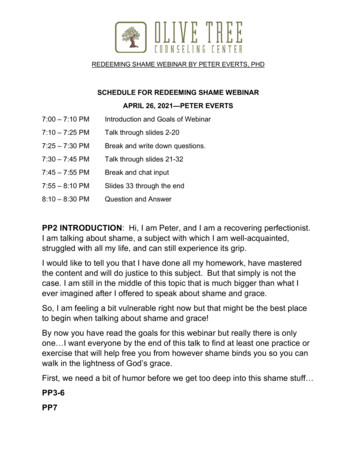
Transcription
REDEEMING SHAME WEBINAR BY PETER EVERTS, PHDSCHEDULE FOR REDEEMING SHAME WEBINARAPRIL 26, 2021—PETER EVERTS7:00 – 7:10 PMIntroduction and Goals of Webinar7:10 – 7:25 PMTalk through slides 2-207:25 – 7:30 PMBreak and write down questions.7:30 – 7:45 PMTalk through slides 21-327:45 – 7:55 PMBreak and chat input7:55 – 8:10 PMSlides 33 through the end8:10 – 8:30 PMQuestion and AnswerPP2 INTRODUCTION: Hi, I am Peter, and I am a recovering perfectionist.I am talking about shame, a subject with which I am well-acquainted,struggled with all my life, and can still experience its grip.I would like to tell you that I have done all my homework, have masteredthe content and will do justice to this subject. But that simply is not thecase. I am still in the middle of this topic that is much bigger than what Iever imagined after I offered to speak about shame and grace.So, I am feeling a bit vulnerable right now but that might be the best placeto begin when talking about shame and grace!By now you have read the goals for this webinar but really there is onlyone I want everyone by the end of this talk to find at least one practice orexercise that will help free you from however shame binds you so you canwalk in the lightness of God’s grace.First, we need a bit of humor before we get too deep into this shame stuff PP3-6PP7
REDEEMING SHAME WEBINAR BY PETER EVERTS, PHDCharlie Brown’s posture says it all? His eyes look away, his shouldersslump, he looks like he is about to shut down and go somewhere to hide.“Shame is embodied”!PP8Shame erodes our soul.It leaves us feeling:-there is something wrong, something lacking or inadequate about us.-we are not worthy of love and belonging.When shame festers and grows, it can consume us.PP9Shame is not like guilt.(Point one) Guilt points to behavior and says, “I did something wrong”;shame points to self and says, “I am wrong”.(Point two) Guilt leads to pro-social action; it moves forward withacknowledgement and repair. Shame triggers a fight/flight/freezeresponse; disconnects us from ourselves, others, and God.Notice how shame triggers us. We may withdraw and isolate from othersor avoid feeling shame by engaging addictive behaviors. We can actangrily towards others or we can turn that anger towards ourselves.Do you see how shame can be so well-disguised? The workaholic, thecodependent, the perfectionist, and the bully—all can share shame at theircore. We will do anything to avoid the feeling of shame!Sometimes we experience guilt and shame at the same time. It can be achallenge to sort out one from the other!For example, when I do something wrong, experience guilt and takeappropriate action, I should feel emotional relief. But if I continue to beat
REDEEMING SHAME WEBINAR BY PETER EVERTS, PHDmyself up for it and persist in “feeling guilty”, I really am experiencingshame.(Skip points three and four.)PP10Is there a sense of healthy shame?Most researchers say, “yes”. Healthy shame helps build social boundaries,a sense of propriety, a kind of humility. My friend and colleague TomWilkinson reminds that healthy shame “is what helps us keep our clotheson” when we go out the door.Perhaps healthy shame works more like guilt, both can lead to constructiveaction. A social miscue that leads to embarrassment can spur someone toapologize even if she is not guilty of anything.PP11Shame is harmful to us.-it shows up in traumatic disorders, all forms of abuse, emotional andbehavioral problems, and underlies addictive patterns.-it undermines our intimate connections in marriage, family, andcommunities.-it distorts our very identity: how we see ourselves, others, and God.PP12What are some key facts about shame and brain functioning?-the experience of shame comes early, well before language ismastered, and well before guilt is formed. Guilt requires development ofconscienceand empathy, which are developed later in childhood.-shame neurons are hard-wired and less adaptive to than otherneurons.
REDEEMING SHAME WEBINAR BY PETER EVERTS, PHD-shame disrupts our thinking, emotions, and behavior.-some good news: the brain is adaptive and can rewire; we can learnnew patterns of reacting and behaving.PP13What are some implications from brain research? I am especially caughtby these questions -if the initial experience of shame is pre-verbal, disruptive, hard-wired, andnot easily remediated, how can we lessen shame’s power while raising andeducating young children?-how do we heal from shame if it is deeply rooted in our brain, not easilyaccessed by language, and yet is so disruptive in its impact? How doesthat influence how we counsel or engage healing practices?PP14How do we heal from shame? Let’s start with the contributions made by acouple of researchers over the last twenty years, Brene Brown and KristenNeff.Brene Brown is a social science researcher on shame. If you have notread one of her books or listened to one of her TED talks or podcasts, Istrongly encourage you to do so.For those who struggle with self-acceptance a good starting point would beto read the Gifts of Imperfection, then follow it up with a deeper look atshame and the role of vulnerability in her subsequent book Daring Greatly.In the Gifts of Imperfection Brown challenges us to live whole-heartedly.As we embrace our imperfections, we have the courage to let go of whatother people think, build compassion by establishing healthy boundaries for
REDEEMING SHAME WEBINAR BY PETER EVERTS, PHDourselves, and connect more intimately with others as we come to selfacceptance.PP15In Daring Greatly Brown concludes that when we vulnerably tell our story tosomeone who offers us empathy and understanding, shame can’t survive.To build shame resilience we need to be able to recognize when shamecomes up in our bodies, to feel our way through it, learn what messagesand expectations triggered it. The next step is to do a reality-check onthese messages. Are they realistic, attainable, what we want or whatothers want from us? Then we need to share our story with someone whocan empathize with us. When we share our story, we are “speakingshame”—talking about how we feel and asking for what we need when wefeel shame. These steps are fluid and do not necessarily happen in order!PP16Brown concludes that being vulnerable is a hallmark of shame resilientpeople—the willingness to be seen, and the willingness to be known. InDaring Greatly, she skillfully writes about the ways we defend against beingvulnerable by wearing vulnerability armor. A helpful read!PP17What are the research findings on self-compassion, especially the work byKristin Neff and her colleague Chris Germer?The goal of self-compassion is not to increase self-esteem but selfacceptance.PP18What does self-compassion look like? It means that we are kind toourselves, when we fail or struggle, we do not isolate but connect to othersand we practice staying in the moment, non-judgmentally, accepting “what
REDEEMING SHAME WEBINAR BY PETER EVERTS, PHDis”. This last concept is what is so difficult for many of us to put intopractice.When I let my perfectionism take over, I experience an inner criticreviewing everything I say or do or think. I worry about the future; I beatmyself up over the past. My body’s cortisol levels start to climb! If I practiceself-compassion, I stop and observe what I am feeling, am thinking I staycurious, not condemning myself for any of the negative messages that arecoming up within me. As I stay non-judgmental, I let my body and emotionsrelax. I become better at letting go of shame’s lies.For those of you who want a Christian perspective on mindfulness Irecommend the books by Oden and Kraeger.PP19Neff uncovers the erosive impact of self-criticism on self-compassion. Shechallenges the myth that self-criticism is the way to do more or performbetter. Self-criticism is a literal attack on ourselves.PP20You have listened to a lot of information about shame, shame resilienceand self-compassion. You can see some of the questions that have comeup for me. But what are your questions or observations at this point in thewebinar? Take 5 minutes and reflect. You may want to write them out nowand share later when the chat function is open near the end of our timetogether. Talk to you in 5 minutes!7:25 – 7:30 PM Break7:30 – 7:45 PMLet’s deepen our own understanding of how shame and grace are centralto our spiritual life.PP22
REDEEMING SHAME WEBINAR BY PETER EVERTS, PHDGerald May, a Christian psychiatrist, wrote a classic called Addiction andGrace (1988). He makes clear that we all desire to be loved and accepted,but we are afraid to be vulnerable. We protect ourselves from the potentialof rejection by engaging in a variety of attachments (idols) or addictivebehaviors, which take us further away from the love and acceptance wedesperately seek. We will come back to him when we talk about grace.Quick note: Attache is the French word that means “nails”. Is it helpful tolook at the Cross as the place where our attachments/addictive behaviorsare “nailed”, crucified and let go? Does this go deeper than what we meanby “Jesus died on the Cross for our sins?”PP23Curt Thompson is a Christian psychiatrist, who applies his understanding ofthe neurobiology of shame, to the Scriptural narrative. In the Gardenfollowing the temptation by the serpent Adam and Eve immediatelyexperience shame, cover themselves and hide even as God gently seeksthem out. In creating us God makes himself vulnerable to us by risking ourrejection. In turn we must become vulnerable to restore our connectionwith God and others.Thompson interprets Good Friday in the most intimate way.(Point 3) “Good Friday is God coming to find us saying that there is noplace in your shame that I am not present and already there waiting foryou and I am going to wait for you until you open your eyes to me beingwith you in that space, and let Resurrection take us both home.”(Skip point four)
REDEEMING SHAME WEBINAR BY PETER EVERTS, PHDPP24Simon Cozens, who spent time as a worker in an honor and shame culture,wrote Looking Shame in the Eye (2019). He brings theology, psychology,and cultural anthropology to the intersections of shame and grace.Jesus took on shame not only on the Cross, but it was at the very heart ofhis ministry and teaching. While I don’t think Jesus tried to shame theleaders of his day, when he confronted their role in the shame-basedreligious system that they had created, he provoked their “shame blame”which ultimately led to his arrest and death.But when Jesus engaged those who were shamed, he put himself at risk,became vulnerable, saw through their shame, honored the worth of theindividuals and freed them to no longer be in bondage to their shame.Notice Jesus and the Samaritan woman at the well, how they both takerisks with each other, and Jesus makes it safe for the woman toacknowledge her shame and be released from it. Or how about the Lukanaccount of the prostitute who risks social shame in Simon’s house; whereJesus turns shame on its head and pronounces that the prostitute not onlyhas honored him over and above what his host has failed to do, but that hershame redeemed allows her to love more deeply than those who don’tthink they need shame redemption!So much more to explore here, but we need to move forward.PP25(For the sake of time, I will leave you to ponder Clapp’s brief, butpenetrating analysis of shame and his challenge to us.)Rodney Clapp, a prolific Christian writer, wrote a penetrating analysis ofshame and the Cross in a brief article from a Christianity Today magazinepublished in 1991.He makes a prophetic statement about how we as believers must not joinour shame-based culture’s denial of shame and too quickly run from the
REDEEMING SHAME WEBINAR BY PETER EVERTS, PHDCross where shame is crucified to the Resurrection where hope obliteratesshame.The challenge? “Our hope is that resurrection transforms andparadoxically elevates the shame of crucifixion.” What would it mean toembody this paradox in our spiritual practice?PP26Lewis Smedes, a former professor of Christian ethics at Fuller Seminary,wrote a classic book called Shame and Grace. Both simply written andprofound; it is still relevant today.Grace is understood by Smedes as four dimensional: it pardons guilt,overcomes shame, empowers us into the “lightness of grace” and deepensour gratitude and joy!PP27Are we worthy of grace? The answer is yes! We don’t deserve grace; it isa gift and unmerited, but we are worthy of it! Grace accepts us for who weare right now. God does not ignore our fallenness, but he also does notdiminish our inherent worth. We are image-bearers, inherently worthy, butshame has eroded our self-worth and grace provides a way to restore it.PP28Does grace lead us to self-forgiveness, self-acceptance, or both? Theanswer is both. “When we forgive ourselves, we heal our guilt; when weaccept ourselves, we heal our shame. Forgiving ourselves is spade workwe do on the way to accepting ourselves.”When I hear someone say, “I know that God forgives me, but I cannotforgive myself”, I wonder how much grace he or she has received. Isuspect that guilt is gone but shame and lack of self-acceptance continuesto have full sway.PP29
REDEEMING SHAME WEBINAR BY PETER EVERTS, PHDGerald May views grace not only as a gift but a challenge. The challengeis to go on a spiritual journey of relinquishment of our attachments (idols).During that journey we “discover the depths of our weakness, the power ofgrace and the price of both” until we find our worth that comes fromdependence on God.A perfect example of this is when God did not remove Paul’s “thorn in theflesh”— which was humiliating to Paul. Paul walks through the desert ofunanswered petitions, hears God’s voice saying, “My grace is sufficient foryou, for my power is made perfect in weakness.” Of course, God doesn’tenjoy Paul’s humiliation, but offers a Grace so empowering that Paulmoves from humiliation to humility and a deeper dependence upon God.PP30(Skip this) I want to reserve this slide for later in our time together. Itis a wonderful example of embodied grace, but let’s move on.PP31If grace is so inviting, why do we resist it? Let us look at some of thereasons I think about. I would welcome any thoughts you have about itduring our Q and A.(Read the first point.) Those of us who have worked hard, madesacrifices, done the right thing, if honest, we find grace difficult to receive.We have built our identity around achievement and merit. The prodigal sonis thrown a party, the laborers who started work at the beginning of the dayget the same wage as those who show up with a few minutes left in theday. Grace upends our merit system.(Read the second and third points.) We cannot do it alone; we needsupport and assistance along the way. This is hard for many of us to admit.Ask most recovered addicts what the secret to recovery is and they will tellyou about their inability to recover on their own, dependency upon God andreliance on a group of other recovering addicts on their road to sobriety.We need to learn from them!
REDEEMING SHAME WEBINAR BY PETER EVERTS, PHD(Read the fourth point.) When we FEEL abandoned by God, we still mayhold onto the fact of God’s love, but it doesn’t feel this way. It is hard tofeel the benefits of grace: its lightness, joy, and gratitude. We need toprocess our pain with someone who will not give answers to the why; butwill help us with our lament.PP32(Read the fifth point.) Leaving grace at the pardoning of sin, and notincorporating its healing for shame is like going to a party and opening upjust one gift and leaving the others unopened. Grace is meant to heal ourshame as well.(Read the sixth point.) We have been hurt, betrayed, or judged when wehave become vulnerable and risked our shame with others—including inour faith communities. The shame that was risked in sharing has only beenreinforced. This is a travesty; this is Shame’s proudest moment.If grace is to be embodied through us, we must make our relationshipssafe; we must hold confidences; we must hold sacred all the spiritualjourney someone is on without judgment. Vulnerability offered needs to bereceived with vulnerability.(Read the seventh point.) We accept salvation as a gift, freedom fromsin, our guilt and penalty paid. Then we go about trying hard to imitateChrist, follow Biblical teachings and spiritual improvement plans that resultin more failure and shame. I will talk more about this later in the webinar.(Read the eighth point.) We will come back to this later.We are about to take a 10-minute break. Please get up and stretch for afew minutes but I would like you to come back and use the chat function.Make your observations or questions about shame and grace brief. Youalso may wish to share a resource or a practice for healing shame with us.Please forward them to Lisa and Amber. They will organize your questionsand responses for our Q and A that will follow my presentation.(Then break for 10 minutes.)
REDEEMING SHAME WEBINAR BY PETER EVERTS, PHDPP33Welcome back! Please feel free to use the chat function if you havequestions that come up as we come to our close.Let’s look at how shame shows up in cross-cultural living. I believe thoseof you who live in these settings face some unique challenges. Here aresome of the most common statements we hear.Notice how we struggle with “am I enough?” as we learn a new language,find energy for our work, spend money, write support letters PP34Feel spiritually empty, struggle with team members, have personalproblems that question our spirituality PP35Face burnout, lack sufficient joy, and carry doubt about calling.Later you might come back to these questions and ask: Where is shamearising in these situations—from within the worker or from others? What arethe messages of shame? What would it mean to practice shame-resiliencein each of these situations?I want to add this before moving on.Many of us know how difficult cross-cultural living is. As we try to fulfill ourvision and demonstrate our effectiveness, we can allow shame to come inthe back door and whisper, even shout: You are not enough!Yet there can be another layer of difficulty--that is, we can be shamed byteam members, leaders in ministry areas, by our supporters, and by theorganizations to which we belong. When this shame goes unhealed orunrecognized, the burdens of living cross-culturally grow even moredifficult.
REDEEMING SHAME WEBINAR BY PETER EVERTS, PHDThe good news is that you can still build shame resilience in the face ofthis; but you will need to find grace-filled relationships elsewhere!PP36Now let’s turn to some practices in healing shame. When you receive myPP talk after the webinar, you will see that I have offered some suggestionsfor each of these practices that we will not have time to review. So, I willfocus on just a few.PP37Let’s look at the first 4 practices. All of them encourage you to dig moredeeply into your own story; then you are challenged to share your processwith someone else or within a small group.When we have a chance to rework our stories, we can give them newmeaning and perspective. When we are emotionally vulnerable in sharingour stories with someone who enters into our experience, we have achance to heal from shame. You can read more about this in Thompson’sAnatomy of the Soul, especially pages 65-80.A powerful example of embodied grace can be found on PP30. MichaelCusick, author of Surfing for God, shares his story of how an early sexualabuse memory sent him reeling backwards in time. God invited him to askfor the presence of a close friend to enter into this painful experience. Hisfriend became the embodiment of grace to Cusick as he healed from theshame of his childhood abuse memory.Go to PP38 and skip below:1. Start with the first step in shame resilience andrecovery acknowledging where shame shows up in your lifeand how you manage it. How do you experience shame? Whatare its triggers? How do you respond to shame? Share this with aperson who knows you the best, who can speak truth gently andlovingly. Ask for feedback about how he or she sees you.
REDEEMING SHAME WEBINAR BY PETER EVERTS, PHD2. Make an inventory of your unhealthy attachments (idols) oraddictions. You may also wish to read May or Rohr (BreathingUnder Water) for assistance. What function do they serve in yourlife? How have you tried to relinquish them? What was yourexperience? With whom can you share your inventory and givesupport in letting go of your unhealthy attachments?3. Create your own narrative about shame and grace in your life.Find someone who can be the face of Jesus for you; share yourstory openly and courageously. Shame and grace are embodied;the way out of shame and into grace must be embodied as well.4. Study Brown’s Gifts of Imperfection along with Pritchard’scompanion guide Worthy in Jesus in a small group. Use theguidelines for sharing that Pritchard suggests and find embodiedgrace for your imperfections in thegroup.PP385. Develop an embodied theology of shame and grace as youreflect on Scripture. Books by Thompson, Smedes, Wilks orCozens may be helpful templates. If you have primarily viewedsalvation through the lens of guilt and disobedience, what would itmean to view salvation through the lens of shame and shameredeemed? What would it mean to embody a theology of shameand grace? What spiritual practices would you engage? How wouldthe good news be shared? Would our witness to the world be betterserved if we spoke the language of shame rather than one of guilt,morality, and sin? (Cozens)6. Treat yourself with compassion and acceptance—especiallywhen you fail. Resources by Neff, Oden and Kraeger can help.Listen to your inner dialogue during the day; write down what your
REDEEMING SHAME WEBINAR BY PETER EVERTS, PHDthoughts are about yourself. Can you allow Christ’s compassion totransform your self-criticism into gentle self-acceptance, embracingyour imperfection and seeking the gracious acceptance of others?7. Let go of the gap between your “ideal self” and your “actualself”—it only increases your shame. Many of us strive to “beperfect as our Heavenly Father is perfect” and be “imitators ofChrist”. We are quick to read another Christian self-help book orlisten to a podcast on how to be a better “whatever” but end upfaulting ourselves when we fail to do it well. The difference betweenwho we are and who we want to be becomes a point of spiritualmeasurement. We can begin a process of shaming ourselvesbelieving we are not “faithful, spiritually mature or whatever enough”.The truth is that we are worthy of God’s love for our actual selves,both the parts that are visible, but also the shadowy parts. WhileGod yearns for us to love as completely as he does, his love andacceptance is not affected by our performance; it only seems toimpact our view of ourselves!For those of you inclined to be perfectionistic, read the articlesout of the Oneing journal on Perfectionism or read about TypeOne on the Enneagram. If you would like a quick laugh about thesubject, go to https//idea.library.drexel.edu and locate the MPerformance Standards chart for cross-cultural workers. My sisterJana who is a worker in Costa Rica put me onto this.8. Witness to your imperfections using the language of shame andshame redeemed. Cozens argues that whether we are fromWestern (individualistic) or Eastern (group-oriented) cultures, we endup experiencing shame. Our world is in search of authentic andgenuine connections. “If our witness is to show people how muchwe need Jesus, then we need to share our failures” (Fischer),become vulnerable and speak the language of shame redeemed.
REDEEMING SHAME WEBINAR BY PETER EVERTS, PHDPP399. Read authors who understand that the most profoundexperience of grace often comes through suffering and shame.Books by Yancey, Manning, Nouwen, Rohr in Falling Upwardscome to mind. Read the Biblical accounts of God’s unfailing pursuitin deliverance from our shame; but especially read the Gospelaccounts of how Jesus addresses shame. Cozens helps here.10.Explore how shame uniquely intersects with yourEnneagram type. All of us experience shame; but we are likely tobe triggered differently depending upon our attachment histories, ourtraumatic experiences and by our personality types. If youappreciate the wisdom underlying the Enneagram, then listen to thepodcast in 2020 created by Cron, a co-author of The Road Back toYou, who interviews Curt Thompson on shame and enneagramtypes.11.Engage Christian contemplative practices that involve“being” not “doing”. Many of our prayer practices engage averbal, structured, left-hemisphere approach and ignore ancientChristian practices, such as, centering prayer, breath prayers, theJesus prayer, welcoming prayer, the prayer of examen, practicingthe presence of God—all of which may better ground us in ourbodies and daily rhythms. (Resources: Oden, Bourgeault andEdwards)12.Observe rest and engage relinquishing practices. Keepingthe Sabbath requires us to stop our striving; reminds us of letting goof outcomes and our busyness to God. Periods of silence andsolitude strip us of our normal activities, which can help to reveal ourattachments and addictive patterns. Fasting practices, from eating
REDEEMING SHAME WEBINAR BY PETER EVERTS, PHDto unplugging from the screen, can also have the same effect. ReadMay’s description of the desert journey.PP40As you look at these practices, the common thread running throughthem is to engage not just your left hemisphere, but right hemisphereas well! Grace needs to be embodied!13.Absorb Scripture through the practice of lectio divina andother non-analytic methods. If we can engage our imaginationand not approach Scripture simply to study or memorize, we improveour capacity to retain its powerful stories of shame and grace whenwe do this. The use of lectio divina invites us to let the Spirit speakto us as we reflect, not analyze; non-analytic methods encourage usto imagine ourselves being one of the characters in the biblicalstories we read to experience more profoundly its message.14.Engage as many senses as possible to experience graceand shame redeemed. Listen to music that lifts our spirits, has uscry confessionally and/or with joy, is grace-filled. We retain wordsand phrases much better alongside body movement and song thatis embodiment! Sing the psalms. Use body posture and movementwhile praying or meditating. Read books on grace out loud to eachother. Watch movies with redemptive themes that can engage ouremotions, where shame and suffering meet grace. (my favorites: TheMission, Les Miserables and Schindler’s List) Walk in God’s creationand marvel at the constant cycles of death and renewal, life out ofdecay.15.Develop your capacity for beauty, joy, and gratitude.Everything we create suggests beauty—including whenbrokenness is restored, or ruptures are repaired. Imagine Jesus
REDEEMING SHAME WEBINAR BY PETER EVERTS, PHDduring the day saying to you, “I love you. I love how ” Or imagine aloving Father speaking personally to you through his Word daily (goto FathersLoveLetter.com). Be grateful for not just the specialgraces (answer to prayers, salvation experience, etc.) but also forthe ordinary graces, from our own breathing to all the ways we arebeing sustained daily by God). Experience the “lightness of Grace”,the experience of being loved in whatever ways that comes to youdaily.PP4116.Deepen the practice of confession and forgiveness as avital pathway to release shame and restore intimate connection.When we privately confess to God and receive His forgiveness forour sin and shame, we bypass a powerful way to renew our minds.(Thompson and Cozens)In our counseling my wife and I recommend a comforting confessionto heal hurts caused in relationships. This happens when a sincereapology is made only after the emotional pain that has been causedby the offender is understood. Deep apology requires the ability toempathize with the one who has been hurt. When that happens,forgiveness and connection deepens.James 5:14-16 serves as a reminder for what can happen in ahealthy, confessional faith community.17.Seek spiritual direction or life coaching with someone whocan listen to your story of shame and grace. A spiritual directoror life coach can help reflect with you what you are discoveringabout yourself and God.PP42(Read this power point slide without comment.)PP43
REDEEMING SHAME WEBINAR BY PETER EVERTS, PHDSome closing observations We need grace-filled relationships and communities to assist us in movingout of shame.How can the church in its worship, sacraments, practices, disciplines, andwitness create a healing place for shame? How can we practiceconfession and forgiveness so that actual healing and repair of our mutualshame is embodied?We always have lived in a world where shame tells us that we are notworthy of love and belonging. In the 21st century the corrosive, souleating effects of shame have been heightened as we can nowinstantly react out of our shame by blaming, defriending, bullying, andjudging through social media platforms. We can “cover our shame”by presenting what we want others to see about us, but in so doingour longing to be accepted for who we really are goes unfulfilled. Ourworld desperately needs to know how to redeem shame, it needspeople who know personally and collectively how to deal with theirown shame and walk in the lightness of grace.PP44I will end my presentation with how Lewis Smedes ended his book onShame and Grace. I encourage you to author your own versionsome day!(Read Smedes free verse.)PP45-48This list of sources is only a beginning. I know that there are manymore good sources on this subject. For example, I have not read HeatherNelson’s Unashamed: Healing Our Brokenness and Finding Freedomfrom Shame (2016), Sandra Wilson’s Released from Shame: MovingBeyond the Pain of the Past (2002)
Shame erodes our soul. It leaves us feeling: -there is something wrong, something lacking or inadequate about us. -we are not worthy of love and belonging. When shame festers and grows, it can consume us. PP9 Shame is not like guilt. (Point one) Gu
